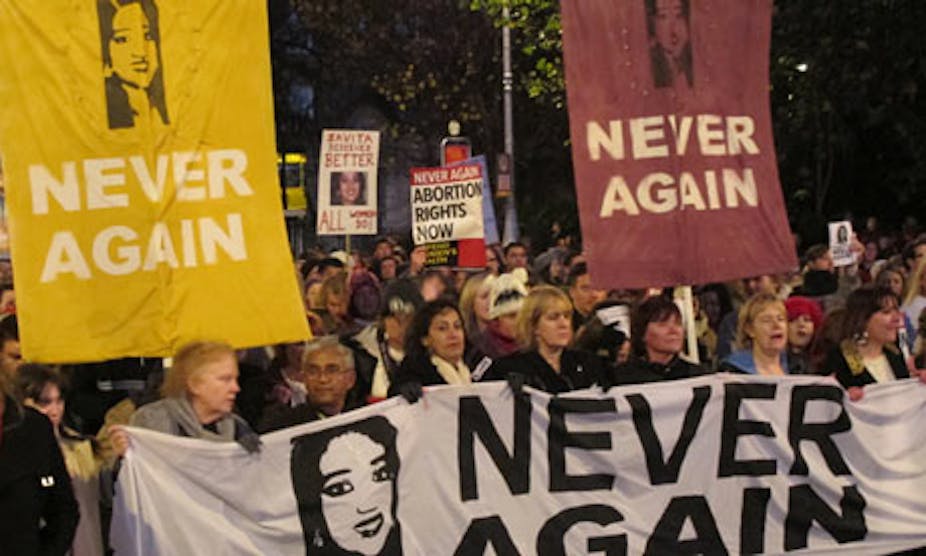Savitia Halappanavar was a symbol of all that is positive about cultural diversity in Ireland. A young Indian Hindu, she had embraced Irish culture, partaking in St Patrick’s day festivities and playing an active role within her community. Her horrific, slow death and the subsequent dignity of her husband, Praveen Halappanavar, in speaking out about it, reignited the emotive debate around abortion in Ireland, highlighting the failure of successive Irish governments to legislate for it.
On Monday the 12th of November, Ireland was elected to the United Nations Human Rights Council. The government, which had been on a charm offensive trying to mend its international reputation, was quick to big note itself. The Tánaiste (Deputy Leader) and Minister for Foreign Affairs, Eamonn Gilmore, stressed the position on the council was “hugely important” for Ireland and called it “a major endorsement” of the country’s international standing. By the end of the week, news of the death of Savitia Halappanavar had broken, and Ireland’s human rights record was being discussed all around the world. Across Ireland people took to the streets, making a whole new generation of women aware of what the Irish constitution says about them and their bodies.
It’s 20 years since the 1992 X case, when the Dublin High Court prevented a 14-year-old rape victim from travelling to England for an abortion. At the time, thousands took to the streets demanding she be allowed travel. With anger growing, the Supreme Court ruled that the girl had a right to an abortion in Ireland stating: “it is established as a matter of probability that there is a real and substantial risk to the life, as distinct from the health, of the mother, which can only be avoided by the termination of her pregnancy.”
Two referenda were held as a result of the X case, in 1992 and 2002, to try to set aside the threat of suicide as grounds for a legal abortion. The government was defeated in both. The 1992 referendum also guarantees women the right of information and to travel abroad for abortion. The expert group report on abortion was finally published this week. The report was commissioned as a result of a complaint to the European Court of Human Rights from 2005, by three women who alleged that restrictions on abortion in Ireland were in breach of their human rights. The case became known as A, B & C v Ireland. The 2010 judgement from this case accepted that Ireland has the sovereign right to decide on the availability of abortion but that if there is a right to access abortion, there must be a system for that right to be exercised.
Irish citizens and the courts both domestically and internationally have been clear what they want the legislature to do. What has occurred is the failure for over 20 years by successive Irish governments who have refused to legislate. The choice after A, B & C v Ireland was clear either put in place a process where the medical profession had clear guidelines about applying the X case or hold yet another constitutional referendum to either narrow or broaden the case.
The death of Savitia Halappanavar also illustrated the ambiguities and lack of clarity within the system. Whilst the Irish Medical Council have clear guidelines on abortion, medical experts are divided on the correct course of action. It is also worth noting that the majority of Irish hospitals are run under under a Catholic ethos which has had a brutal historical impact. Earlier this year women recounted their experiences on being forced to travel to England to end pregnancies despite being told the foetus could not live after birth. We were also reminded of the status of women within the constitution, where on one hand Article 40 protects the life of the unborn with due regard to the equal life of the mother, whilst Article 41 contains an antiquated clause of mothers’ duties within the home. The reaction of the government - made up of a coalition between Fine Gael (a conservative centre-Right party), which promised not to legislate for the X Case, and the Labour Party (centre-Left), whose election manifesto committed itself to broadening access to abortion - has been slow. There have been tensions between both parties on what steps to take as both sides of the debate prepare to lobby.
This week I was reminded of a debate former president Mary Robinson partook in 1983. Very little has changed. Watching this story break from abroad has been depressing and inspiring in equal measures. Abortion is no longer an issue Ireland can export. The world is watching as Ireland takes over the EU presidency on the 1st of January 2013. The legislature needs to act. We owe it the the memory of Savitia Halappanavar and her family to legislate.

